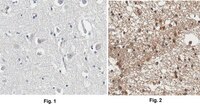MAB343-C Sigma-AldrichAnti-APP Antibody, CT, clone 2.F2.19B4, Ascites Free
This Anti-APP Antibody, CT, clone 2.F2.19B4, Ascites Free is validated for use in Immunohistochemistry (Paraffin), Immunocytochemistry, Immunoprecipitation, Western Blotting, Immunofluorescence, Affinity Binding Assay for the detection of APP.
More>> This Anti-APP Antibody, CT, clone 2.F2.19B4, Ascites Free is validated for use in Immunohistochemistry (Paraffin), Immunocytochemistry, Immunoprecipitation, Western Blotting, Immunofluorescence, Affinity Binding Assay for the detection of APP. Less<<Recommended Products
Áttekintés
| Replacement Information |
|---|
Kulcsspecifikációk táblázata
| Species Reactivity | Key Applications | Host | Format | Antibody Type |
|---|---|---|---|---|
| H, M | IH(P), ICC, IP, WB, IF, ABA | M | Purified | Monoclonal Antibody |
| References |
|---|
| Product Information | |
|---|---|
| Format | Purified |
| Presentation | Purified mouse monoclonal IgG1κ antibody in buffer containing 0.1 M Tris-Glycine (pH 7.4), 150 mM NaCl with 0.05% sodium azide. |
| Quality Level | MQ100 |
| Physicochemical Information |
|---|
| Dimensions |
|---|
| Materials Information |
|---|
| Toxicological Information |
|---|
| Safety Information according to GHS |
|---|
| Safety Information |
|---|
| Storage and Shipping Information | |
|---|---|
| Storage Conditions | Stable for 1 year at 2-8°C from date of receipt. |
| Packaging Information | |
|---|---|
| Material Size | 100 μg |
| Transport Information |
|---|
| Supplemental Information |
|---|
| Specifications |
|---|
| Global Trade Item Number | |
|---|---|
| Katalógusszám | GTIN |
| MAB343-C | 04055977355406 |
Documentation
Anti-APP Antibody, CT, clone 2.F2.19B4, Ascites Free MSDS
| Title |
|---|
Anti-APP Antibody, CT, clone 2.F2.19B4, Ascites Free Certificates of Analysis
| Title | Lot Number |
|---|---|
| Anti-APP, CT, clone 2.F2.19B4, Ascites Free - 3511582 | 3511582 |
| Anti-APP, CT, clone 2.F2.19B4, Ascites Free - 4248875 | 4248875 |
| Anti-APP, CT, clone 2.F2.19B4, Ascites Free -Q2696992 | Q2696992 |







